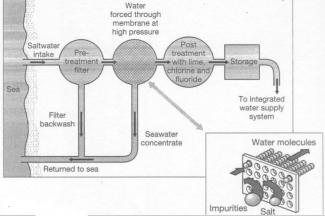Summarize the information by selecting and reporting the main features and make comparisons where relevant.

The illustration shows the process of the removal of sea salt in order to get fresh and clean water. Overall, there are three main stages in the process from the initial unusable-water filtration to the final drinkable-water production.
First of all, the amount of raw water taken from the ocean is pumped into the filter. After that, the filter is backwashed and is then returned to the environment. After the removal of contaminants and undesirable components, the usable water is transported to the membrane which is considered as the most important area during the process.
In the second stage of the process, the water is filtered at the membrane under strict conditions such as high pressure. In addition, the structure of the membrane is extremely complicated with numerous holes whose diameters are fitted for the size of water molecules, which leads to the result that the salt molecules and impurities are restricted to pass through this layer, and are then returned to the ocean.
Before the storage and distribution, the filtered water is treated with some disinfectants including lime, chlorine, and fluoride which destroy bacteria and soften water. Finally, the freshest and cleanest water can be used after a wide range of careful steps above.
----------------------------
Point: 6.5
Comments:
- Lack of some features.
- Lack of description of backwash in the second paragraph (body 1) and explanation in detail in the third paragraph (body 2).
--------------------------- SAMPLE 2 ----------------------
The provided process illustrates how to make drinkable water from seawater. It is noticeable that the process undergoes three stages namely pre-treatment, filter and distribution.
At the pre-treatment phase, seawater is prepared to be treated. First, salt water is piped from the sea to the pre-treatment filter where solid matters are trapped allowing only water to pass through. Following that, the impurities are returned to the sea by the effect of filter backwash.
In the second step, the water from the previous stage is completely filtered. After being passed through the pre-treatment filter, the water is forced through a membrane at high pressure. The membrane is a micro-filter on which there are holes small enough for water molecules to enter while larger dirty substances and salt are screened. The product is carried to the next stage while the by-product again by filter backwash is flushed back to the sea.
Finally, drinkable water is processed for safety. Lime, chlorine, and fluoride are added into the water in order to disinfect bacteria and viruses. At this point, the water is safe to drink prior to being stored and piped into the water supply system.
--------------------------- SAMPLE 3 ----------------------
The emergence of the Internet in the 20th century has resulted in both pros and cons. A significant number of opponents believe that this advent has done more harm than good. Personally, the Internet poses some problems, which could be accompanied by appropriate solutions.
It has been a long-rooted perception that the Internet leads to disappointing academic performance. Spending time surfing websites may fill learners’ schedules with fruitless activities, which distract them from their studying. This, in turn, probably decreases their academic results in the long term.
Another possible drawback of cyberspace seems to be dangers in some aspects of their life. The sedentary lifestyle appears to associate with some health-related problems including obesity and cardiovascular diseases, which are the result of the lack of outdoor physical activities.
A feasible measure to the two detrimental effects above could be the collaboration of parents and schools. By means of controlling the time used for the Internet and filtering web content, they could place some limits and create a better network for their children. A major technical challenge of this measure is the parents and schools’ ignorance of parental control software and features.
It cuts both ends. The Internet is a useful tool for some but a knife for others. In order to prevent these downsides, there should be a balance among users in particular and appropriate policies in general.
Không có nhận xét nào:
Đăng nhận xét